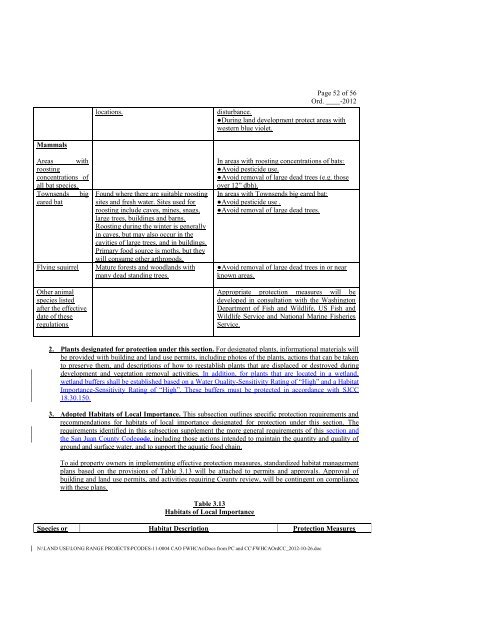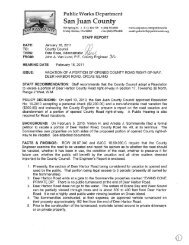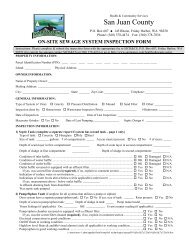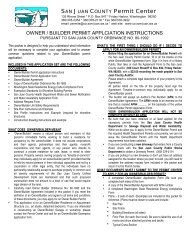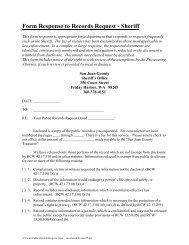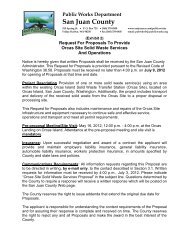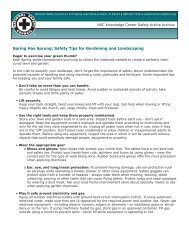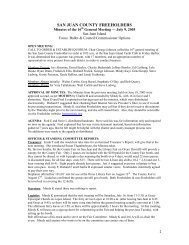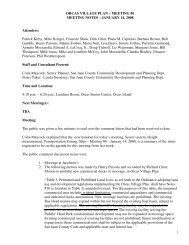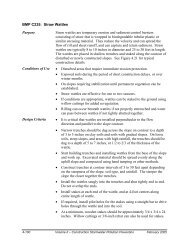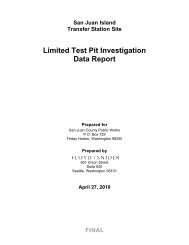Ordinance No._____- 2012 AN ORDINANCE ... - San Juan County
Ordinance No._____- 2012 AN ORDINANCE ... - San Juan County
Ordinance No._____- 2012 AN ORDINANCE ... - San Juan County
You also want an ePaper? Increase the reach of your titles
YUMPU automatically turns print PDFs into web optimized ePapers that Google loves.
locations.<br />
Page 52 of 56<br />
Ord. ____-<strong>2012</strong><br />
disturbance.<br />
●During land development protect areas with<br />
western blue violet.<br />
Mammals<br />
Areas with<br />
roosting<br />
concentrations of<br />
all bat species.<br />
Townsends big<br />
eared bat<br />
Flying squirrel<br />
Other animal<br />
species listed<br />
after the effective<br />
date of these<br />
regulations<br />
Found where there are suitable roosting<br />
sites and fresh water. Sites used for<br />
roosting include caves, mines, snags,<br />
large trees, buildings and barns.<br />
Roosting during the winter is generally<br />
in caves, but may also occur in the<br />
cavities of large trees, and in buildings.<br />
Primary food source is moths, but they<br />
will consume other arthropods.<br />
Mature forests and woodlands with<br />
many dead standing trees.<br />
In areas with roosting concentrations of bats:<br />
●Avoid pesticide use.<br />
●Avoid removal of large dead trees (e.g. those<br />
over 12” dbh).<br />
In areas with Townsends big eared bat:<br />
●Avoid pesticide use .<br />
●Avoid removal of large dead trees.<br />
●Avoid removal of large dead trees in or near<br />
known areas.<br />
Appropriate protection measures will be<br />
developed in consultation with the Washington<br />
Department of Fish and Wildlife, US Fish and<br />
Wildlife Service and National Marine Fisheries<br />
Service.<br />
2. Plants designated for protection under this section. For designated plants, informational materials will<br />
be provided with building and land use permits, including photos of the plants, actions that can be taken<br />
to preserve them, and descriptions of how to reestablish plants that are displaced or destroyed during<br />
development and vegetation removal activities. In addition, for plants that are located in a wetland,<br />
wetland buffers shall be established based on a Water Quality-Sensitivity Rating of “High” and a Habitat<br />
Importance-Sensitivity Rating of “High”. These buffers must be protected in accordance with SJCC<br />
18.30.150.<br />
3. Adopted Habitats of Local Importance. This subsection outlines specific protection requirements and<br />
recommendations for habitats of local importance designated for protection under this section. The<br />
requirements identified in this subsection supplement the more general requirements of this section and<br />
the <strong>San</strong> <strong>Juan</strong> <strong>County</strong> Codecode, including those actions intended to maintain the quantity and quality of<br />
ground and surface water, and to support the aquatic food chain.<br />
To aid property owners in implementing effective protection measures, standardized habitat management<br />
plans based on the provisions of Table 3.13 will be attached to permits and approvals. Approval of<br />
building and land use permits, and activities requiring <strong>County</strong> review, will be contingent on compliance<br />
with these plans.<br />
Table 3.13<br />
Habitats of Local Importance<br />
Species or Habitat Description Protection Measures<br />
N:\L<strong>AN</strong>D USE\LONG R<strong>AN</strong>GE PROJECTS\PCODES-11-0004 CAO FWHCAs\Docs from PC and CC\FWHCAOrdCC_<strong>2012</strong>-10-26.doc


